Protecting Yourself From a Bad Valuation
A practice or real estate sale is usually a high-stakes transaction involving hundreds of thousands, or millions, of dollars changing hands. Quite often, the buyer and seller will base the price paid for a practice on an appraisal or valuation that has been done by an accountant.
…And yet, if a business or real estate is put to market with competitive bids, it is quite common for the price paid to vary from the valuation price. Why is this? And what are the ways that you can minimise your risk when relying on a valuation?
1. Poor or incomplete information provided to the valuer
A valuer is only as good as the information that has been provided and is accessible to them. If relevant information has been withheld or made unavailable, they cannot be expected to be accurate.
Check: If you are getting a valuation done, make sure that the valuers have all the necessary relevant and accurate information. The valuation should list the reference documents that the valuer assessed to come to their appraisal.
2. Timing
The appraised value of a business may be accurate at the time that it is created, but may change significantly over a relatively short period if:
a. The fortunes of the practice change due to key clinicians leaving, physical damage to the premises (fire, flood, etc.), its reputation is damaged, etc.
b. There is a perceived or real change in global or local economic conditions. Examples of this may be interest rate changes, GFC, pandemic causing panic.
c. There are new announced changes in the local area. Examples of this may include key employers investing or divesting in the area, or if there is a development or new infrastructure announced in the area.
Check: If you are basing a transaction decision on a valuation, make sure that the valuation has occurred within the last 6 months. If the valuation was done before, you should be asking for it to be reviewed by the valuer.
3. Poor choice of valuer
Some people will just go to their trusted family accountant to appraise a vet practice. While your accountant is probably very experienced and trustworthy, a vet practice valuation is not just the application of accounting principles. To value a business effectively, the valuer needs to have an understanding of the industry norms of the business they are valuing and have access to information about comparative practice transactions/sales.
If your accountant doesn’t have this experience and exposure to comparative financials, they are likely to miss vital pieces of information or apply an incorrect/inappropriate multiple to their appraisal. An inexperienced valuer would value the practice using the same methodology and formula that they would use for a coffee shop or travel agency (we see this regularly).
Check: If you are basing a transaction decision on a valuation, make sure that the valuation was done by a valuer experienced in the industry being valued. In our opinion, there are only 2 or 3 valuers in the vet industry with enough industry knowledge to be accurate on a consistent basis. Ask specialist lenders/financiers in the profession – if they haven’t heard of the valuer, it may not be the correct one to be basing your transaction on.
4. Terms
There is no price without terms. Price is often a function of risk and much of the risk protection is in the terms of the deal. For example, corporates have been known to offer higher valuations for practices, but these higher prices come with more onerous post-sale conditions (years of post-sale commitment, revenue and profit targets, etc.).
Action: If you are basing a transaction decision on a valuation, make sure that the valuation specifies the basic terms that the valuation is predicated upon (i.e., post-sale commitment, premises lease terms, etc.).
5. Lack of comparable transactions.
Business valuations are only accurate to the extent that the valuer has a thorough knowledge of the market for the business being valued.
The more unique a business is (if it is highly specialised or located in an extremely remote location), the less likely it is that there are comparable transactions for a valuer to use in their assessment. This can affect the ability of the valuer to predict the demand and appetite for this business.
6. Fact VS Emotion
A valuation is usually an objective assessment of the available relevant facts. However, people often do not act objectively in the marketplace. For example:
- A buyer may fall in love with a business or property and offer more than market rate because of how convenient the location is (close to their home, their children’s school, etc.) live.
- They may offer more due to “fear of missing out” (FOMO), social proof (e.g., seeing lots of interest at an auction) and search fatigue.
It is extremely difficult for a valuer to factor these external emotional components into an appraisal.
Action: No one can take the possibility of a ridiculous offer into account when valuing a practice but, at the same time, a valuation that gives you a reasonable range is more likely to have taken into consideration the emotion factor.
